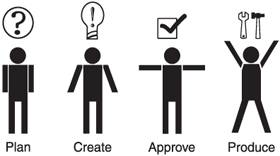Chapter 2. Planning for Production
| Why plan? The answer might seem obvious, yet how many of us thoroughly plan our content creation and distribution exercises in this fast turnaround, impossibly deadline-driven industry? You really should preplan. This step solicits feedback from all the resources before the project is created, saving costly time and money and avoiding the mistakes that impact production. When you know your goal, you can plan the finished product or service. In addition, you have all your questions answered, the budget approved, the message approved, the distribution method chosen, so you simply need to plan the manufacturing steps, coordinate your resources, and implement your timeline. Many tasks are required to publish content and several hand-offs. You will be collaborating internally with sales and marketing professionals, engineers, and operations staff; you'll also communicate externally with photographers, print service providers, graphic artists, and web developers. So, when you tackle the assignment of publishing content, planning is very important. You shouldn't create something you can't actually produce or manufacture, and you don't want to spend a lot of time and money arriving at a deadline only to find out you are going to cost the company more time and money because you didn't realize the implications your creativity had on budget and manufacturing. Essentially you are involved in a four-step process:
After your message has been approved and you have planned your distribution, you probably have already begun the manufacturing process. However, unlike most manufacturing processes, the manufacturerin this case, the print service providerdoes not control the beginning of manufacturing process. You do. Figure 2.1. Your creative workflow: plan, create, approve, produce. Note
Let's say you work for an auto manufacturer and are in the advanced product concepts department, tasked with coming up with new ideas for cars. Car designers collaborate with engineers throughout the design process to ensure that the design can be translated into a product with the materials and machinery at hand. What would happen to any manufacturing process if, say, 70% of the materials were so flawed that they had to be fixed before manufacturing could begin? Could a printer stay in business if her paper vendor kept supplying her with 70% flawed stock? Of course not, yet 70% of all incoming digital files supplied by their customers contain serious flaws, which require analysis, intervention, and repair. That's quite a challenge. So, it's important that the creative people collaborate with the manufacturing peoplethe print service provider, document manager, web developer, and so forthto ensure that the manufacturing process can achieve the requested product and that the process flows smoothly, on time, and on budget. You know the old adage, "failing to plan is planning to fail." Failure to plan costs time and money no matter what industry you are in, and the bottom line is affected. Affect the bottom line enough, and there will be no content to distribute. You need to answer the following questions: What is the message? Who will we send it to? and How will we get it there? |
EAN: 2147483647
Pages: 148
